In the atmosphere, both temperature and pressure decrease with altitude, and have conflicting effects upon density. However, the fairly rapid drop in pressure as altitude is increased usually has the dominating effect. Hence, density can be expected to decrease with altitude.
Effect of Temperature on Density
In the atmosphere, both temperature and pressure decrease with altitude, and have conflicting effects upon density. However, the fairly rapid drop in pressure as altitude is increased usually has the dominating effect. Hence, density can be expected to decrease with altitude.
Podrel
Here is one discussion thread in Finnish about it:
Nyt on suomen kolmas akuankkakone valmis
It has staggered wings (two wings, one on top of each other). What if it was completely different. Not exactly completely, but quite completely. Now on this latest Super Petrel, the engine pod is integrated to the upper wing. How if the upper wing was the only wing on the plane, the lower wing would not exist, the upper wing would be twice as long. The tail would not be angled upwards from the bottom of the fuselage, but it would be rather connected with two booms to the wing, in similar manner than it has been done on Adam A500. And finally, but not least, what if the fuselage was not a traditional fuselage, but a pod in the end of a strut, that fits the occupants, and nothing more. It would end before the prop arc. This would allow moving the propeller a bit downwards.
So the result:
- no aerodynamic penalty normally associated with the amphibian planes.
- center of thrust is at the same level as is the lift (high wing)
- because of the boom tail, the tail does not hit the water unless the plane flips.
- because you would not need to fit the tail to the fuselage, the fuselage-pod could be made a better boat shape
I could not resist, but name this idea as Podrel. Actually this is not a new idea entirely, it is partially borrowed from a NASA tech paper, but the application to amphibian use could be new twist for the configuration.
What do you think about this?
No Jat Airways privatisation
 Jat Airways will not be privatised, instead the Serbian government will invest a large sum of money in order to restructure and modernise the company as announced the Serbian ministry of economics. The ministry blames the current global economic and airline crisis for the failure of the privatisation tender. The first step now is a meeting between the Serbian Prime Minister Mirko Cvetković and the directors of Jat Airways. They will have to agree on how to restructure Jat in order for costs to decrease and efficiency to increase. Jat’s management and unions are expecting restructuring, a decrease in the number of employees and the company’s modernisation. The Serbian Government will remain the sole owner of Jat.
Jat Airways will not be privatised, instead the Serbian government will invest a large sum of money in order to restructure and modernise the company as announced the Serbian ministry of economics. The ministry blames the current global economic and airline crisis for the failure of the privatisation tender. The first step now is a meeting between the Serbian Prime Minister Mirko Cvetković and the directors of Jat Airways. They will have to agree on how to restructure Jat in order for costs to decrease and efficiency to increase. Jat’s management and unions are expecting restructuring, a decrease in the number of employees and the company’s modernisation. The Serbian Government will remain the sole owner of Jat.We will keep you updated.
Dynaero MCR-01
Front:

Dynaero smile:

Back:

Double slotted flaps:

Flap mechanism:
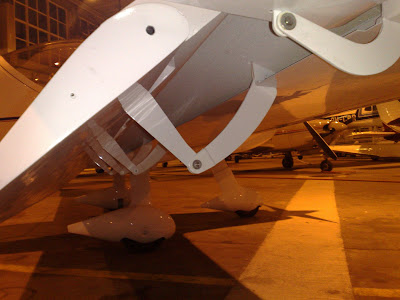
Canopy:
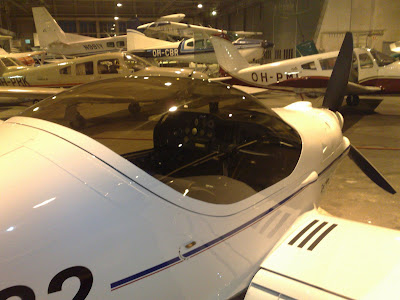
Interesting finding: the upper slot is rigid part of the flap. It does not move by itself, and the mechanism is as simple as on plain flap or the single slotted flap found on Cirrus or Diamond. When the flap is retracted, the slot hides under the wing. Very clever design.
Who gets the most air traffic?
 Eurocontrol is the European Organisation for the Safety of Air Navigation. Created in 1963 by six founding members, this civil and military intergovernmental organisation now counts 38 Member States from across Europe. It is based in Belgium with specialised offices in six other European countries. Not only does it keep Europe’s skies safe, it also compiles information on air traffic. These are the results for countries of the EX-YU:
Eurocontrol is the European Organisation for the Safety of Air Navigation. Created in 1963 by six founding members, this civil and military intergovernmental organisation now counts 38 Member States from across Europe. It is based in Belgium with specialised offices in six other European countries. Not only does it keep Europe’s skies safe, it also compiles information on air traffic. These are the results for countries of the EX-YU:Bosnia and Herzegovina: In August the total number of departures from Bosnian airports amounted to 698 arrivals and 700 departures while 23.471 aircraft flew over Bosnian airspace. These results are an improvement compared to last year when there were 644 departures, 649 arrivals and 22.804 overflies. Overall Bosnia and Herzegovina has seen an increase in air traffic every month with the number of overflies increasing the most, meaning more aircraft are flying over the country’s airspace.
Croatia: Not only is August one of the busiest months for air traffic in Croatia but the country is also seeing improvements across all months when compared to last year. In August alone there were 4.527 commercial departures, 4.396 arrivals and a total of 38.324 overflies. However the August 2008 results did not see a large improvement in traffic figures as some previous months. In August 2007 there were only 51 departures less nevertheless this number was made up by the large increase in arrivals. A total of 197 more arrivals took place in August 2008 then in 2007.
Macedonia: Despite MAT being banned from Greece, causing a large decrease in charter operations, Macedonia is recording a big improvement compared to last year over all months. August was particularly successful this year when there were 645 departures compared to 527 in August 07, 643 arrivals compared to 527 the same time last year and in August there were a total of 16.107 overflies compared to 14.385 last year.
Serbia and Montenegro: Serbia controls Montenegro’s airspace until further notice and as a result all data is combined with no separated information available. Similarly Belgium takes care of Luxembourg’s airspace. Nevertheless Serbia and Montenegro are recording the largest increase in operations. In August 2008 there were 3.479 departures compared to last year’s 2.787, 3.492 arrivals compared to 2.800 and 50.285 overflies compared to 42.687 in August 2007. The increase in overflies can be thanked to Serbia’s ideal geographical location. The largest increase in passenger operations was seen in May 2008 which can be largely thanked to the Eurovision Song Contest that was held in Belgrade seeing an increase in air traffic.
Slovenia: Slovenia is also seeing an increase in operations particularly in January and February. In August 2008 Slovenia saw 2.054 departures, 2.057 arrivals and 31.134 overflies. This compared to August 2007 when there were 1.930 departures and 1.970 arrivals. However Slovenia has seen a slight decrease this year in overflies when compared to 2007. In August 2007 Slovenia has a total of 31.253 overflies.
When all data is calculated the leading countries in August 2008 are:
1. Serbia and Montenegro
2. Croatia
3. Slovenia
4. Bosnia and Herzegovina
5. Macedonia
Effects of Pressure on Density
Cargo centre delayed again
 The tender to find a strategic partner for the construction of the largest cargo terminal in the Balkans to be located at Belgrade Nikola Tesla Airport has been delayed again, 2 years after an agreement with American DynCorp failed. The CEO of Belgrade’s Airport did not determine a new date for the tender. The CEO states that the airport is currently analysing the American and global economic crisis and the effect this can have on air cargo transport. Belgrade Airport is looking for a company which would build a cargo and logistics centre at the airport which would significantly increase cargo operations and make Belgrade Nikola Tesla the largest cargo destination in the region.
The tender to find a strategic partner for the construction of the largest cargo terminal in the Balkans to be located at Belgrade Nikola Tesla Airport has been delayed again, 2 years after an agreement with American DynCorp failed. The CEO of Belgrade’s Airport did not determine a new date for the tender. The CEO states that the airport is currently analysing the American and global economic crisis and the effect this can have on air cargo transport. Belgrade Airport is looking for a company which would build a cargo and logistics centre at the airport which would significantly increase cargo operations and make Belgrade Nikola Tesla the largest cargo destination in the region.After an agreement with DynCorp, signed in 2006, which was employed to build the new terminal failed, the CEO of Belgrade’s Airport is hoping that whenever a new company is found it will already be a cargo centre operator. Meanwhile the CEO announced that the construction of a third terminal would commence in 2010.
N Z Fire Service training
750XL ZK-JPP lost.
For further details see http://aviation-safety.net/wikibase/wiki.php?id=22911
Under sources click on "Paravia"for more aerial shots of JPP.
Click on "TSR Video"for accident site shots.
Tks to Ray for headsup.
Atmospheric Pressure
Though air is very light, it has mass and is affected by the attraction of gravity. Therefore, like any other substance, it has weight, and because of its weight, it has force. Since it is a fluid substance, this force is exerted equally in all directions, and its effect on bodies within the air is called pressure. Under standard conditions at sea level, the average pressure exerted on the human body by the weight of the atmosphere around it is approximately 14.7 lb./in. The density of air has significant effects on the airplane’s capability. As air becomes less dense, it reduces (1) power because the engine takes in less air, (2) thrust because the propeller is less efficient in thin air, and (3) lift because the thin air exerts less force on the airfoils.
Question time #23 winner
Jat Airways privatisationNo bids at tender
 Jat Airways Union representatives say that no company has bought the tender documentation for the sale of the national carrier. The Privatisation Agency and the Ministry of Economy officials would neither confirm nor deny these claims. The deadline to buy the tender documentation expired on Friday, September 26 at midnight. The ministry did however say that "technically, it is possible that an offer sent by mail on Friday afternoon could still arrive", as was the case with B&H Air. Aeroflot, Air Berlin, Iceland Air and Air India were all mentioned earlier in the summer as the possible buyers.
Jat Airways Union representatives say that no company has bought the tender documentation for the sale of the national carrier. The Privatisation Agency and the Ministry of Economy officials would neither confirm nor deny these claims. The deadline to buy the tender documentation expired on Friday, September 26 at midnight. The ministry did however say that "technically, it is possible that an offer sent by mail on Friday afternoon could still arrive", as was the case with B&H Air. Aeroflot, Air Berlin, Iceland Air and Air India were all mentioned earlier in the summer as the possible buyers. The Ministry of Economy said in June that the starting price for Jat would be EUR 150 million for 100% of its shares. However, by July 31, when the tender was at last called, the minimal price for a 51 percent stake was set at EUR 51 million. This price was determined on the basis of the data submitted by the company itself, with no independent auditing. The union now blames the world economic crisis and the state's irresponsible behaviour for the drop in the value of Jat Airways. It states that the airline should have be put on sale as planned late last year and early last year when there were strong contenders for the purchase.
The Ministry of Economy promised that if the tender was unsuccessful it would give Jat a financial injection to purchase new aircraft and would wait at least a year until putting the airline on sale again. Meanwhile it is expected that in a few weeks a new CEO will be named by the government ending Vlaisavljević’s one year as head of Serbia’s national airline, having had many critics. Meanwhile the sale for Jat Tehnika looks much better with 4 companies buying tender documentation. Three of these are known the the public while the fourth, still unknown, is now widely speculated to be Boeing following the meeting between the company and Serbia’s heads of state in New York a few days ago.
Structure of the Atmosphere
Air, like any other fluid, is able to flow and change its shape when subjected to even minute pressures because of the lack of strong molecular cohesion. For example, gas will completely fill any container into which it is placed, expanding or contracting to adjust its shape to the limits of the container.
The atmosphere is composed of 78 percent nitrogen, 21 percent oxygen, and 1 percent other gases, such as argon or helium. As some of these elements are heavier than others, there is a natural tendency of these heavier elements, such as oxygen, to settle to the surface of the earth, while the lighter elements are lifted up to the region of higher altitude. This explains why most of the oxygen is contained below 35,000 feet altitude.
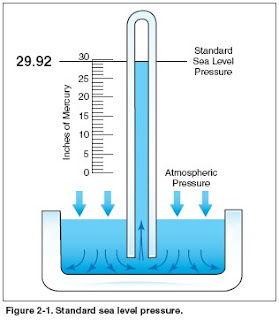 Because air has mass and weight, it is a body, and as a body, it reacts to the scientific laws of bodies in the same manner as other gaseous bodies. This body of air resting upon the surface of the earth has weight and at sea level develops an average pressure of 14.7 pounds on each square inch of surface, or 29.92 inches of mercury—but as its thickness is limited, the higher the altitude, the less air there is above. For this reason, the weight of the atmosphere at 18,000 feet is only one-half what it is at sea level. [Figure 2-1]
Because air has mass and weight, it is a body, and as a body, it reacts to the scientific laws of bodies in the same manner as other gaseous bodies. This body of air resting upon the surface of the earth has weight and at sea level develops an average pressure of 14.7 pounds on each square inch of surface, or 29.92 inches of mercury—but as its thickness is limited, the higher the altitude, the less air there is above. For this reason, the weight of the atmosphere at 18,000 feet is only one-half what it is at sea level. [Figure 2-1]Belgrade Nikola Tesla Airport privatisationAdvisor by the end of the year
 The tender for finding the privatisation advisor for Belgrade Nikola Tesla Airport could be opened by the end of the year announced CEO Bojan Krišto. “The sdvisor will prepare the privatisation of the airport within next year, which will be done through the public sale of shares, implying that the company will until the go through reorganisation and will create a well devised plan of development” he explained. Krišto estimated that airport shares, soon to be enlisted on the stock exchange, “would be a true hit” and will contribute to better operation activities of the company and the privatisation of Serbia’s national airline Jat Airways. He added that the decision on the amount of shares to be sold through privatisation will be reached by the Serbian Government, while some proposals will be made by the privatisation advisor. “I believe that no more than 50% of the airport will be sold, with the most realistic expectations being between 30% and 32%”. He stated that it is difficult to determine the value of Nikola Tesla Airport as the company is not listed on the stock exchange. “After enlistment, the value of the company is assessed on the market”, said Krišto.
The tender for finding the privatisation advisor for Belgrade Nikola Tesla Airport could be opened by the end of the year announced CEO Bojan Krišto. “The sdvisor will prepare the privatisation of the airport within next year, which will be done through the public sale of shares, implying that the company will until the go through reorganisation and will create a well devised plan of development” he explained. Krišto estimated that airport shares, soon to be enlisted on the stock exchange, “would be a true hit” and will contribute to better operation activities of the company and the privatisation of Serbia’s national airline Jat Airways. He added that the decision on the amount of shares to be sold through privatisation will be reached by the Serbian Government, while some proposals will be made by the privatisation advisor. “I believe that no more than 50% of the airport will be sold, with the most realistic expectations being between 30% and 32%”. He stated that it is difficult to determine the value of Nikola Tesla Airport as the company is not listed on the stock exchange. “After enlistment, the value of the company is assessed on the market”, said Krišto.
Question time #23
The Powerplant
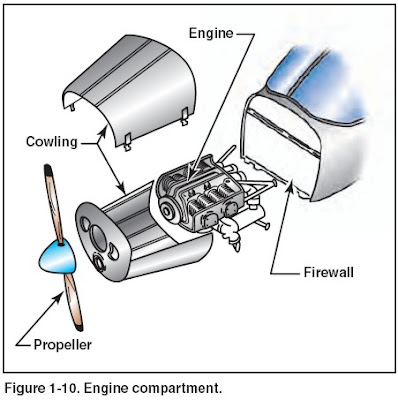
Nacelle—A streamlined enclosure on an aircraft in which an engine is mounted. On multiengine propeller-driven airplanes, the nacelle is normally mounted on the leading edge of the wing.
Red light for Croatia Airlines from FAA
 The American federal aviation administration, the FAA, yesterday, on their Internet webpage published that Croatia does not meet the standards of the international civil aviation organisation, ICAO. The checks were carried out in January 2008 after Croatia Airlines signed an agreement with United Airlines. The deal allowed for passengers to fly with Croatia Airlines to a European destination and then continue their journey to America using United. Croatia has therefore been rated in the “category 2” class. This means that Croatia either does not have the needed laws and regulations for trans-Atlantic flights or employees in the country’s aviation industry are not trained in the areas of technical knowledge, aircraft inspection and so on.
The American federal aviation administration, the FAA, yesterday, on their Internet webpage published that Croatia does not meet the standards of the international civil aviation organisation, ICAO. The checks were carried out in January 2008 after Croatia Airlines signed an agreement with United Airlines. The deal allowed for passengers to fly with Croatia Airlines to a European destination and then continue their journey to America using United. Croatia has therefore been rated in the “category 2” class. This means that Croatia either does not have the needed laws and regulations for trans-Atlantic flights or employees in the country’s aviation industry are not trained in the areas of technical knowledge, aircraft inspection and so on.Landing Gear
most common type of landing gear consists of wheels, but airplanes can also be equipped with floats for water operations, or skis for landing on snow. [Figure 1-9]

The landing gear consists of three wheels—two main wheels and a third wheel positioned either at the front or rear of the airplane. Landing gear employing a rearmounted wheel is called conventional landing gear. Airplanes with conventional landing gear are sometimes referred to as tailwheel airplanes. When the third wheel is located on the nose, it is called a nosewheel, and the design is referred to as a tricycle gear. A steerable nosewheel or tailwheel permits the airplane to be controlled throughout all operations while on the ground.
Question time #22 resolved.
Barry. Not AMY either. Again; that was not the question.
Barry. (again). Indeed the starboard wing : but outboard of the engine at the wing attachment.
mr 47. Put your three cornered hat on (the one with the big letter "D " on it).
Pic is of ZK-DAK at Westport on 27-03-2007 during its NZ tour covering the NZNAC anniversary.
Well done all.
Stand by for something more taxing.
Good NLF airfoil
Question time #22
First sightings at Ashburton
Jat Airways to introduce flights to Milanas Rome stays in network
 Jat Airways will, despite earlier financial troubles, commence flights to a new destination from October 26 to Milan Malpensa Airport. The destination which was just added into the reservation system will be operated using an ATR72. Flight JU416 will be operated three times a week on Tuesday, Friday and Sunday. The flights on Tuesday and Sunday will depart from Belgrade at 13.10 while they will return from Milan at 16.25. Friday will provide a morning flight for passengers, departing Belgrade’s Nikola Tesla Airport at 8.30 and departing back to Belgrade at 11.45. The price of tickets will range from 99 to 259 Euros.
Jat Airways will, despite earlier financial troubles, commence flights to a new destination from October 26 to Milan Malpensa Airport. The destination which was just added into the reservation system will be operated using an ATR72. Flight JU416 will be operated three times a week on Tuesday, Friday and Sunday. The flights on Tuesday and Sunday will depart from Belgrade at 13.10 while they will return from Milan at 16.25. Friday will provide a morning flight for passengers, departing Belgrade’s Nikola Tesla Airport at 8.30 and departing back to Belgrade at 11.45. The price of tickets will range from 99 to 259 Euros. Alitalia operates flights from Milan to Belgrade however the airline is already bankrupt and could lose its license to fly in a matter of days, giving Jat Airways an opportunity to capitalise on its new destination. Jat already operates flights to Rome and Trieste in Italy although Rome was planned to be cut from Jat’s network it has now been decided for it to stay until firther notice.. For now, Milan will be the only newly introduced service in the winter 2008/09 schedule together with Thessaloniki which has been in operation since summer and will continue through winter. All changes to Jat’s winter schedule can be read here.
New 172 sightings at Timaru
ZK-SID Cessna 172S Skyhawk SP , c/n 9523 , caught outside its immaculate hangar at Timaru.
This was registered as ZK-SID on 24-04-2008 to SID McAuley.
It was previously ZK-JPT with the Wakatipu Aero Club (Air Wakatipu) from 24-12-2003.
PIC below of ZK-JPJ2 at Queenstown on 16-08-2006.
This is a rebuild of ZK-SBJ which is a 1976 model; imported into NZ by Rob Leach for S B Jones of Mossburn and registered on 31-01-1979. About eight more operaters are listed before its accident at Lake Sumner on 31-10-1998 when it failed to get airborne from a wet strip.
I believe it was a Avtek rebuild at Timaru.
Empennage
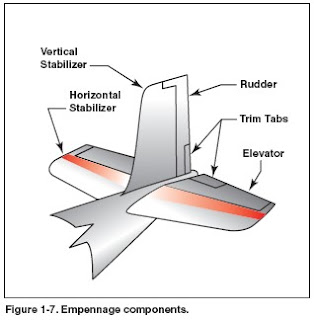 The correct name for the tail section of an airplane is empennage. The empennage includes the entire tail group, consisting of fixed surfaces such as the vertical stabilizer and the horizontal stabilizer. The movable surfaces include the rudder, the elevator, and one or more trim tabs. [Figure 1-7]
The correct name for the tail section of an airplane is empennage. The empennage includes the entire tail group, consisting of fixed surfaces such as the vertical stabilizer and the horizontal stabilizer. The movable surfaces include the rudder, the elevator, and one or more trim tabs. [Figure 1-7]A second type of empennage design does not require an elevator. Instead, it incorporates a one-piece horizontal stabilizer that pivots from a central hinge point. This type of design is called a stabilator, and is moved using the control wheel, just as you would the elevator. For example, when you pull back on the control wheel, the stabilator pivots so the trailing edge moves up. This increases the aerodynamic tail load and causes the nose of the airplane to move up. Stabilators have an antiservo tab extending across their trailing edge. [Figure 1-8]
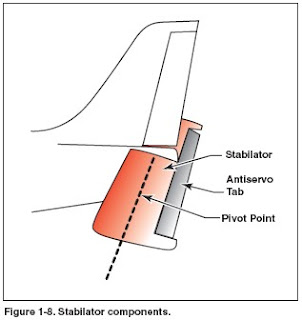 The antiservo tab moves in the same direction as the trailing edge of the stabilator. The antiservo tab also functions as a trim tab to relieve control pressures and helps maintain the stabilator in the desired position.
The antiservo tab moves in the same direction as the trailing edge of the stabilator. The antiservo tab also functions as a trim tab to relieve control pressures and helps maintain the stabilator in the desired position.The rudder is attached to the back of the vertical stabilizer. During flight, it is used to move the airplane’s nose left and right. The rudder is used in combination with the ailerons for turns during flight. The elevator, which is attached to the back of the horizontal stabilizer, is used to move the nose of the airplane up and down during flight.
Trim tabs are small, movable portions of the trailing edge of the control surface. These movable trim tabs, which are controlled from the cockpit, reduce control pressures. Trim tabs may be installed on the ailerons, the rudder, and/or the elevator.
Empennage—The section of the airplane that consists of the vertical stabilizer, the horizontal stabilizer, and the associated control surfaces.
Toyota General Aviation aircraft
Read the arcticle from here:
http://mojaveskies.blogspot.com/2008/07/toyota-in-sky.html
B&H Airlines privatisationTurkish Airlines confirms bid
 It came as a surprise when in late August it was revealed that the much publicised bid by Turkish Airlines for Bosnia and Herzegovina’s national airline – B&H Airlines was not. The Bosnian Privatisation Agency only received a joint bid from the Islamic Bank of Reconstruction and Development and Royal Jordanian Airlines, the national airline of Jordan. However the agency did announce that any offer which arrives by mail within the next 2 days would be accepted as it might have travelled for a longer time. There was one bid sent by mail and it was from Turkish Airlines, already a favourite for the purchase. Tukey and Bosnia and Herzegovina have extremely close economic and diplomatic ties for more than a decade.
It came as a surprise when in late August it was revealed that the much publicised bid by Turkish Airlines for Bosnia and Herzegovina’s national airline – B&H Airlines was not. The Bosnian Privatisation Agency only received a joint bid from the Islamic Bank of Reconstruction and Development and Royal Jordanian Airlines, the national airline of Jordan. However the agency did announce that any offer which arrives by mail within the next 2 days would be accepted as it might have travelled for a longer time. There was one bid sent by mail and it was from Turkish Airlines, already a favourite for the purchase. Tukey and Bosnia and Herzegovina have extremely close economic and diplomatic ties for more than a decade.There have been documentation problems with the bid from the Islamic Bank and it is now being considered not allow the bid to be accepted as a result. The Bosnian Privatisation Agency is now determining who has sent in the best offer and this should be revealed on September 29 after which formal talks between the winning bidding company and the Bosnian government will commence with the deal to be finalised in late October. The new owner which will control 49% of the airline will be required to keep the name of the company, its seat in Sarajevo and purchase at least one aircraft with a minimum 100 seat capacity.
Wings
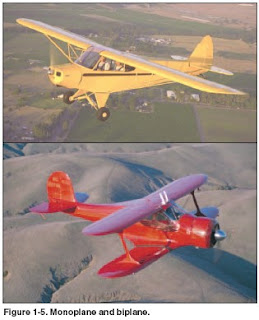 Wings may be attached at the top, middle, or lower portion of the fuselage. These designs are referred to as high-, mid-, and low-wing, respectively. The number of wings can also vary. Airplanes with a single set of wings are referred to as monoplanes, while those with two sets are called biplanes. [Figure 1-5]
Wings may be attached at the top, middle, or lower portion of the fuselage. These designs are referred to as high-, mid-, and low-wing, respectively. The number of wings can also vary. Airplanes with a single set of wings are referred to as monoplanes, while those with two sets are called biplanes. [Figure 1-5]Many high-wing airplanes have external braces, or wing struts, which transmit the flight and landing loads through the struts to the main fuselage structure. Since the wing struts are usually attached approximately halfway out on the wing, this type of wing structure is called semi-cantilever. A few high-wing and most low-wing airplanes have a full cantilever wing designed to carry the loads without external struts.
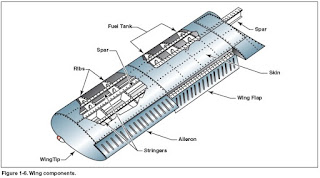 The principal structural parts of the wing are spars, ribs, and stringers. [Figure 1-6] These are reinforced by trusses, I-beams, tubing, or other devices, including the skin. The wing ribs determine the shape and thickness of the wing (airfoil). In most modern airplanes, the fuel tanks either are an integral part of the wing’s structure, or consist of flexible containers mounted inside of the wing.
The principal structural parts of the wing are spars, ribs, and stringers. [Figure 1-6] These are reinforced by trusses, I-beams, tubing, or other devices, including the skin. The wing ribs determine the shape and thickness of the wing (airfoil). In most modern airplanes, the fuel tanks either are an integral part of the wing’s structure, or consist of flexible containers mounted inside of the wing.Attached to the rear, or trailing, edges of the wings are two types of control surfaces referred to as ailerons and flaps. Ailerons extend from about the midpoint of each wing outward toward the tip and move in opposite directions to create aerodynamic forces that cause the airplane to roll. Flaps extend outward from the fuselage to near the midpoint of each wing. The flaps are normally flush with the wing’s surface during cruising flight. When extended, the flaps move simultaneously downward to increase the lifting force of the wing for takeoffs and landings.
Airfoil—An airfoil is any surface, such as a wing, propeller, rudder, or even a trim tab, which provides aerodynamic force when it interacts with a moving stream of air. Monoplane—An airplane that has only one main lifting surface or wing, usually divided into two parts by the fuselage.
Biplane—An airplane that has two main airfoil surfaces or wings on each side of the fuselage, one placed above the other.
Madonna sells out seatson Jat Airways and Montenegro Airlines
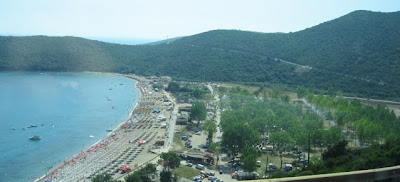 Both Jat Airways and Montenegro Airlines have been sold out on flights between their biggest markets – Serbia and Montenegro as the pop star Madonna prepares to hold her concert in Montenegro’s seaside town of Budva, near Tivat on Thursday September 25. A very large number of Serbian and Croatian fans are expected. During this week 52 return flights will be operated from Belgrade Nikola Tesla Airport to Tivat Airport. On Wednesday and on Thursday all tickets have been sold between the two cities on the 19 flights that will be operated (14 by Jat and 5 by Montenegro Airlines) as well as for the 3 flights to Podgorica to be operated before midday. Belgrade Airport’s management expects that due to the concert 2.000 extra passengers will pass through its doors. Serbia’s national airline Jat Airways has sold 544 tickets for Thursday’s 5 Tivat flights, three of which will be operated by a Boeing 737-300 and 2 using an ATR72. For Wednesday’s 3 flights Jat has sold 198 seats. Jat has also increased its frequencies to Podgorica and sold 318 tickets for Thursday while only a handful of tickets to Montenegro remain. These tickets are to Podgorica on Wednesday. Jat will operate a total of 14 flights to Montenegro on Wednesday and Thursday. Due to the concert Jat is seeing an increase in passengers from Banja Luka and Sarajevo. Montenegro Airlines is also increasing its frequencies. Madonna will for the first time hold her concert in the region. It will be located at Budva’s Jaz Beach (pictured above) and has gained widespread media attention across the EX-YU region.
Both Jat Airways and Montenegro Airlines have been sold out on flights between their biggest markets – Serbia and Montenegro as the pop star Madonna prepares to hold her concert in Montenegro’s seaside town of Budva, near Tivat on Thursday September 25. A very large number of Serbian and Croatian fans are expected. During this week 52 return flights will be operated from Belgrade Nikola Tesla Airport to Tivat Airport. On Wednesday and on Thursday all tickets have been sold between the two cities on the 19 flights that will be operated (14 by Jat and 5 by Montenegro Airlines) as well as for the 3 flights to Podgorica to be operated before midday. Belgrade Airport’s management expects that due to the concert 2.000 extra passengers will pass through its doors. Serbia’s national airline Jat Airways has sold 544 tickets for Thursday’s 5 Tivat flights, three of which will be operated by a Boeing 737-300 and 2 using an ATR72. For Wednesday’s 3 flights Jat has sold 198 seats. Jat has also increased its frequencies to Podgorica and sold 318 tickets for Thursday while only a handful of tickets to Montenegro remain. These tickets are to Podgorica on Wednesday. Jat will operate a total of 14 flights to Montenegro on Wednesday and Thursday. Due to the concert Jat is seeing an increase in passengers from Banja Luka and Sarajevo. Montenegro Airlines is also increasing its frequencies. Madonna will for the first time hold her concert in the region. It will be located at Budva’s Jaz Beach (pictured above) and has gained widespread media attention across the EX-YU region.
Fuselage
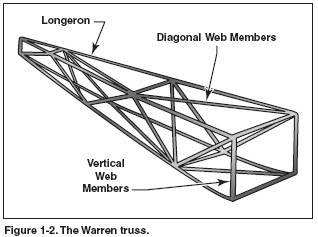 The fuselage includes the cabin and/or cockpit, which contains seats for the occupants and the controls for the airplane. In addition, the fuselage may also provide room for cargo and attachment points for the other major airplane components. Some aircraft utilize an open truss structure. The truss-type fuselage is constructed of steel or aluminum tubing. Strength and rigidity is achieved by welding the tubing together into a series of triangular shapes, called trusses. [Figure 1-2]
The fuselage includes the cabin and/or cockpit, which contains seats for the occupants and the controls for the airplane. In addition, the fuselage may also provide room for cargo and attachment points for the other major airplane components. Some aircraft utilize an open truss structure. The truss-type fuselage is constructed of steel or aluminum tubing. Strength and rigidity is achieved by welding the tubing together into a series of triangular shapes, called trusses. [Figure 1-2]Construction of the Warren truss features longerons, as well as diagonal and vertical web members. To reduce weight, small airplanes generally utilize aluminum alloy tubing, which may be riveted or bolted into one piece with cross-bracing members.
As technology progressed, aircraft designers began to enclose the truss members to streamline the airplane and improve performance. This was originally accomplished with cloth fabric, which eventually gave way to lightweight metals such as aluminum. In some cases, the outside skin can support all or a major portion of the flight loads. Most modern aircraft use a form of this stressed skin structure known as monocoque or semimonocoque construction
The monocoque design uses stressed skin to support almost all imposed loads. This structure can be very strong but cannot tolerate dents or deformation of the surface. This characteristic is easily demonstrated by a thin aluminum beverage can. You can exert considerable force to the ends of the can without causing any damage.
Truss—A fuselage design made up of supporting structural members that resist deformation by applied loads.
Monocoque—A shell-like fuselage design in which the stressed outer skin is used to support the majority of imposed stresses. Monocoque fuselage design may include bulkheads but not stringers.
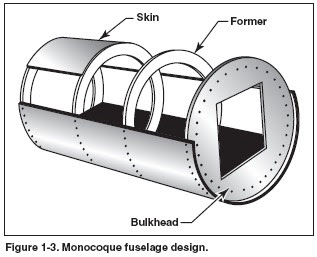 However, if the side of the can is dented only slightly, the can will collapse easily. The true monocoque construction mainly consists of the skin, formers, and bulkheads. The formers and bulkheads provide shape for the fuselage. [Figure 1-3]
However, if the side of the can is dented only slightly, the can will collapse easily. The true monocoque construction mainly consists of the skin, formers, and bulkheads. The formers and bulkheads provide shape for the fuselage. [Figure 1-3]Since no bracing members are present, the skin must be strong enough to keep the fuselage rigid. Thus, a significant problem involved in monocoque construction is maintaining enough strength while keeping the weight within allowable limits. Due to the limitations of the monocoque design, a semi-monocoque structure is used on many of today’s aircraft.
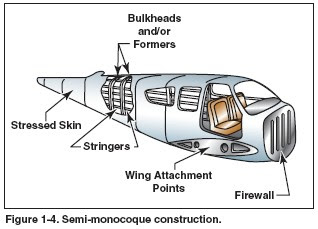 The semi-monocoque system uses a substructure to which the airplane’s skin is attached. The substructure, which consists of bulkheads and/or formers of various sizes and stringers, reinforces the stressed skin by taking some of the bending stress from the fuselage. The main section of the fuselage also includes wing attachment points and a firewall. [Figure 1-4]
The semi-monocoque system uses a substructure to which the airplane’s skin is attached. The substructure, which consists of bulkheads and/or formers of various sizes and stringers, reinforces the stressed skin by taking some of the bending stress from the fuselage. The main section of the fuselage also includes wing attachment points and a firewall. [Figure 1-4]Semi-Monocoque—A fuselage design that includes a substructure of bulkheads and/or formers, along with stringers, to support flight loads and stresses imposed on the fuselage.
On single-engine airplanes, the engine is usually attached to the front of the fuselage. There is a fireproof partition between the rear of the engine and the cockpit or cabin to protect the pilot and passengers from accidental engine fires. This partition is called a firewall and is usually made of heat-resistant material such as stainless steel.
UPDATE: Jat Airways winter 2008/09Farewelling four destinations
 On October 25, 2008 Jat Airways, the national airline of Serbia will begin with its winter schedule. For Jat this usually includes the decrease in frequencies which will occur this year as well however the main difference is that the airline will farewell 5 cities from its destination network as it will decrease its fleet to 9 (6 Boeing 737-300’s and 3 ATR-72’s). Two Boeing 737-300 will be leased to an African airline which is a practice Jat commonly employs during the winter although it is unknown what will occur with the other aircraft, however it is expected they will be returned to their original owners since these aircraft are leased.
On October 25, 2008 Jat Airways, the national airline of Serbia will begin with its winter schedule. For Jat this usually includes the decrease in frequencies which will occur this year as well however the main difference is that the airline will farewell 5 cities from its destination network as it will decrease its fleet to 9 (6 Boeing 737-300’s and 3 ATR-72’s). Two Boeing 737-300 will be leased to an African airline which is a practice Jat commonly employs during the winter although it is unknown what will occur with the other aircraft, however it is expected they will be returned to their original owners since these aircraft are leased.Jat will after many years cease flights to the Albanian capital Tirana. Flight JU412 was operated using an ATR72 twice a week. Another line operated for many years, Malta (Luqa) will also cease and effectively flights to Tripoli will end which were operated via Malta. Flight JU454 to Tripoli via Malta was operated twice a week using a Boeing 737-300. Jat will not return to Oslo this winter. Flight JU394 to the Norwegian capital was operated twice a week however was only planned as a summer destination and was not expected to return to the schedule in the winter. Finally Jat will also farewell another city in Scandinavia - Goteborg will no longer be served.
Jat will also no longer fly to Prague and Munich. These flights will not be pulled out of Jat’s scheduling. It will be operated by partner airlines ČSA and Lufthansa in a strong codeshare collaboration agreement where the flights will be treated as if operated by Jat. Belgrade – Prague JU8170 will be operated with a B737-500, Belgrade - Munich JU8344 will be operated using an Avro RJ85.
The new addition to this year’s winter schedule will be Thessaloniki which was originally planned to be operated only as summer destination however it will continue throughout the winter. Jat Airways will, despite earlier financial troubles, commence flights to a new destination from October 26 to Milano Malpensa Airport. The destination which was just added into the reservation system will be operated using an ATR72. Flight JU416 will be operated three times a week on Tuesday, Friday and Sunday. The flights on Tuesday and Sunday will depart from Belgrade at 13.10 while they will return from Milano at 16.25. Friday will provide a morning flight for passengers, departing Belgrade’s Nikola Tesla Airport at 8.30 and departing back to Belgrade at 11.45. The price of tickets will range from 99 to 259 Euros. All other destinations operated by Jat Airways, including Dubai, Larnaca, western European destinations, Moscow and North African destinations will continue throughout the year. All destinations within the EX-YU will remain in the schedule (Podgorica, Tivat, Sarajevo, Banja Luka, Ljubljana and Skopje).
Any related updates will be posted. Any question our readers might have regarding the new schedule can be posted by using the “comments” option or contacting us using our e-mail address. Soon Croatia Airlines’ 2008/09 winter schedule will be published on the blog.
Question time #21 answer.
Major Component of Aircraft Structure
Aircraft—A device that is used for flight in the air.
Airplane—An engine-driven, fixed-wing aircraft heavier than air that is supported in flight by the dynamic reaction of air against its wings.
MAJOR COMPONENTS
Although airplanes are designed for a variety of purposes, most of them have the same major components. The overall characteristics are largely determined by the original design objectives. Most airplane structures include a fuselage, wings, an empennage, landing gear, and a powerplant. [Figure 1-1]
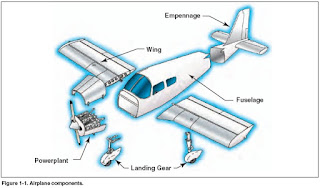
Question time #21 Type correct - but what reg'n ?
But which one ?
Montenegro Airlines privatisation Strategic partner soon
 |
| Podgorica Airport. |
 |
| Montenegro Airlines 2019 |
 |
| Podgorica Airport. |
Croatia Airlines orders new aircraft
 Bombardier Aerospace announced today that Croatia Airlines has signed a contract to acquire two Q400 NextGen turboprop airliners. The airline has also taken options for an additional four aircraft. The transaction represents the conversion of two options taken for Q400 aircraft which was announced on June 4, 2007 when Croatia Airlines also placed a firm order for four Q400 aircraft. Two of those aircraft have already been delivered.
Bombardier Aerospace announced today that Croatia Airlines has signed a contract to acquire two Q400 NextGen turboprop airliners. The airline has also taken options for an additional four aircraft. The transaction represents the conversion of two options taken for Q400 aircraft which was announced on June 4, 2007 when Croatia Airlines also placed a firm order for four Q400 aircraft. Two of those aircraft have already been delivered.Based on the list price for the Q400 NextGen aircraft, the value of the order announced today is approximately $57 million US. The value could increase to $180 million US if all four options are exercised. "The Q400 aircraft is at the very top of the global airline industry in terms of flight specifications, technological achievements and cost-effectiveness, said Ivan Misetic, President and Chief Executive Officer, Croatia Airlines. "We are convinced that by acquiring these aircraft, Croatia Airlines will reaffirm its position as a regional leader in Southeast Europe, besides contributing to connecting Croatia with the world and expanding the Croatian economy". "We are delighted that Croatia Airlines has placed an order for Q400 NextGen airliners so soon after the delivery of its first two Q400 aircraft earlier this year," said Gary R. Scott, president of Bombardier Commercial Aircraft. "It's a solid vote of confidence in these aircraft and we look forward to helping Croatia Airlines build a stronger presence in Europe".
Question time #21
New arrivals for Canterbury Aero Club
They were unloaded from their container on the Skysales pad (a designated Ag clearing area) in the rain on Thursday (18th)
 N3106M is a Archer III as seen above. (To become ZK-LJE).
N3106M is a Archer III as seen above. (To become ZK-LJE).ZK-LJD is a Warrior III, below. Both pics from Glen Reid of Skysales.
 By late Friday afternoon ZK-LJD (below) was coming together nicely in the Club hangar and N3106M is stored alongside.
By late Friday afternoon ZK-LJD (below) was coming together nicely in the Club hangar and N3106M is stored alongside.